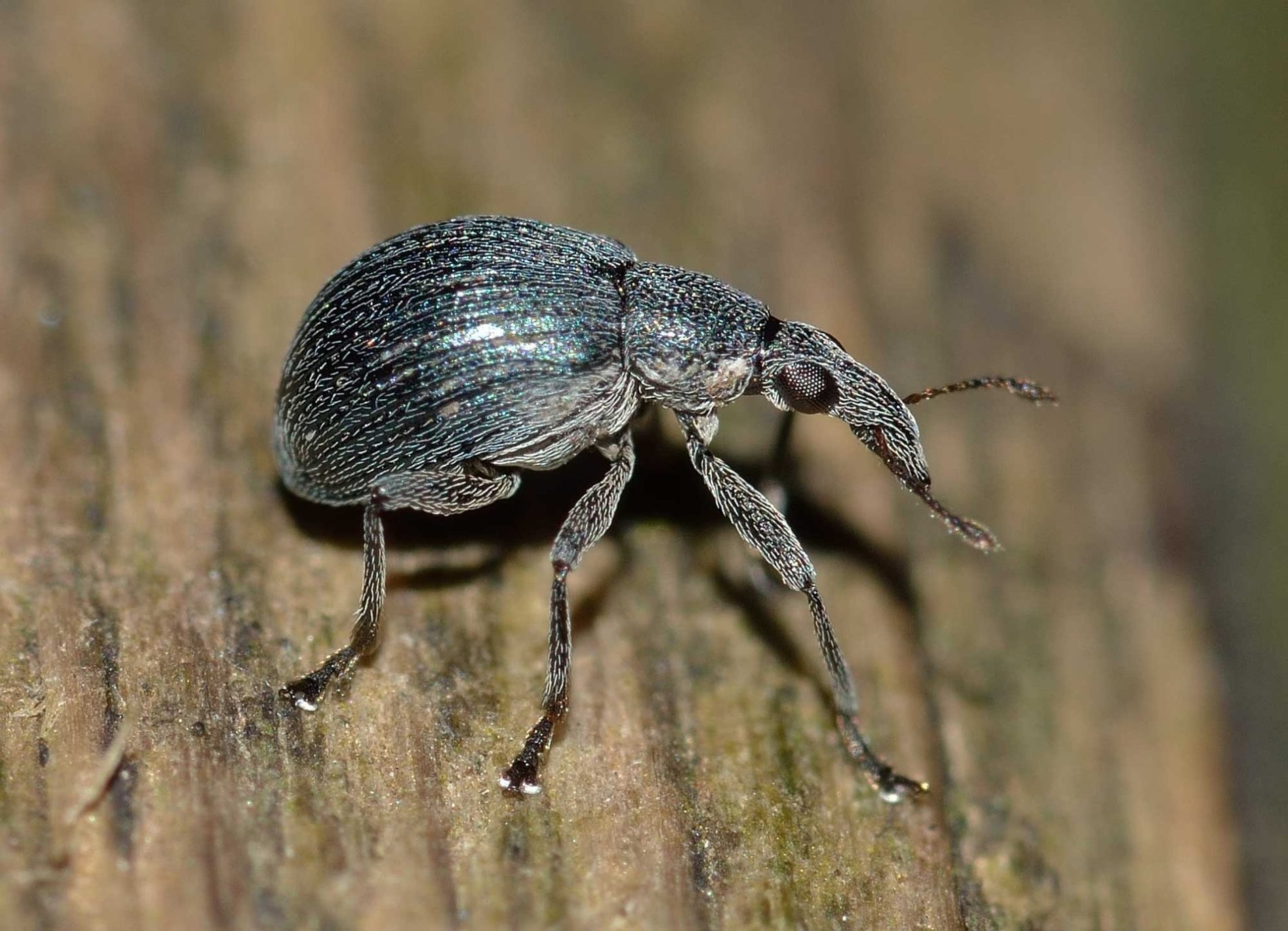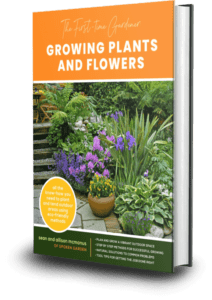Learn natural, earth-friendly ways to eliminate garden pests that wreak havoc in your yard or garden.

If you have a yard or garden, you have pests.
Getting these pests under control or even preventing them from taking up residence is hard work.
However, with a few tricks, you can rid your yard of these pests in a natural, environmentally-friendly way.
By the end of this post, you will learn about our five natural remedies you can use in your garden based on five common garden pests.
Read our Natural Pest Remedies post to learn the following:
- The difference between various types of garden pests
- 5 natural remedies for controlling pests
- Garden pest video links
- Earth-friendly products to purchase now
In a hurry? Pin it for later!!
By the way, this post contains affiliate links. That means that if you click on any of the links we are promoting, we might get a small commission at no cost to you which helps us run our website and podcast.
Natural Pest Control Benefits
Natural or sustainable pest remedies are better for you and your garden because they aren’t hazardous to handle, prepare, or apply and no special training would be necessary.
In addition, you won’t have to concern yourself with violating any federal, state, or county laws. That’s always a good thing.
These organic materials will break down into their natural components after use in your garden with no contamination to your soil, the groundwater, or anything else in your garden. So, no need to call in the hazmat team to come clean up any spills.
These natural remedies tend to be easy to find and purchase, and are usually safer to handle than pesticides from chemical factories. Be sure, though, that you are as safe as you can be when mixing or handling the natural remedies, as most states will deem them as a “pesticide” because of their intended use.
Garden Pests
Any living organism that has a negative effect on your garden or its health is considered a garden pest.
Pests show up in your garden for many different reasons. Some seek shelter while others come hungry noticing that your garden provides tasty meals. Other pests are just short-term guests who pass through or decide to stay for a few days.
Some pests may only need to be treated once in a season, while other pests require consistent, on-going maintenance.
Often you need to use a system of management called IPM, or Integrated Pest Management. To learn more about IPM, check out how to strategize and manage pests in three basic steps.
Types of Garden Pests
For the purposes of this post, we will refer to three different categories of pests: animal, insect, or plant.
Animal Pests:
- Moles
- Slugs/Snails
- Squirrels
- Deer
- Cats
- Raccoons
Insect Pests:
- Aphids
- Caterpillars
- Spider Mites
- White Flies.
Plant Pests:
- Dandelions
- Thistle
- Morning Glory
- Hog-weed
- Grasses
- Clover
Natural Pest Remedies
1) Vinegar Solution
Best for: Weeds
Weeds are plants that tend to out-compete other desired plants and use up finite resources like water, nutrients, space, and light.
A combination of control methods works really well to control weeds in your garden, including hand pulling, roto-tilling, soil modification, mulching, optimum soil moisture, and denser plantings to shade/out-compete undesirable plants. In addition, using a solution of white vinegar, salt, and dish soap can be a great option.
Also, physically blocking weed germination in the soil with burlap or other fabrics with mulch on top can work very effectively. These are much more sustainable and non-threatening to our natural environment and easy to repeat.
General Tips:
- Always try to pull weeds before they go seed after flowering.
- Actually, try to pull or remove them before they even flower so you don’t run the risk of them seeding.
- Some weeds, like dandelions, can germinate, grow, flower, and produce seeds within a one and half or two week period.
- For further resources, check out the Federal Noxious Weeds List.
2) Diatomaceous Earth
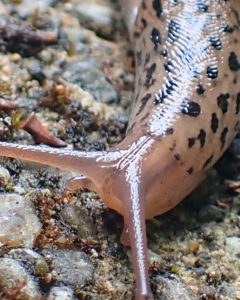
Who wants to welcome this Spotted Leopard slug into their garden?
Best for: Slugs, ants
Slugs are closely related to snails and other mollusks but without a hard shell. They feed on soft plant tissue of many ornamental and vegetable plants, eating the plant leaves, stem, and fruit tissues. Their signature mark is leaving a slimy film over the remaining parts of your plant and a slime-trail to and from the feeding area.
Diatomaceous earth, which is made up of the skeletal remains of microscopic marine creatures, keeps slugs away from plants because they won’t crawl over it.
Make wide rings around planting areas with diatomaceous earth or another slug-repellent paste. Salt works wonders too!
If you see a slug slime-trail, be sure to destroy it so other slugs won’t follow the trail.
3) Castor Oil Pellets
Best for: Moles, gophers, or voles
Moles are in the rodent family, blind, have barely any back legs and their front legs are more like flippers ending with little claws. They eat mostly insects and earthworms.
Being under the surface of your garden, moles tunnel and can sever plant roots. They make their mole-hills as they move the excavated tunnel material to the surface. This makes a manicured lawn look like mini-rolling hills and can seriously damage your lawn mower.
With their tunneling, they create pockets of voided soil where water can collect which can change your gardens’ water drainage and create uneven areas in your garden due to collapsing soil.
Moles can be controlled in a few different ways besides trapping and killing them. It comes down to modifying their food in your garden so they don’t want to visit or make a home there. Different forms of Caster oil from the Caster Bean can be applied so it filters down into the soil. This works really well to deter and push moles out of your yard. The Caster oil coats the mole’s food so it doesn’t taste good.
General Tips:
- Moles and their offspring start to make their hills in your garden in the early spring.
- The hills are connected to each other, so if you want to use bait to make them sick and go away, you can punch holes into their tunnels to place the bait with a broom handle going directly between two hills.
- Be sure to replace and cover the hole you make with a rock or piece of wood so it completely covers the hole thus preventing any light from penetrating into the tunnel.
- If light makes it into the tunnel, the mole will abandon that tunnel due to the threat of predators from above.
4) Insecticidal Soap Spray or Horticultural Oil
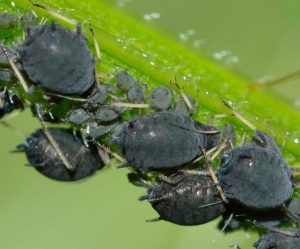
Aphids, an insect garden pest.
Best for: Aphids, whiteflies
Aphids are small white, purple, brown, black, yellow, or green insects that are laid by egg on the underside of plant leaves, where they hatch and start to feed by sticking their needle-like mouth into plant tissues
They use their needle-mouths to suck up and eat leaf cells distorting growth and can discolor tissues to make a speckled or dot-like pattern on the leaves.
While feeding, they can inject a toxin into the plant tissue that makes leaves curl and can further distort growth. They also can produce what’s called “honey-dew”, which is their waste product.
If ants don’t come by to take away and consume the honey-dew, this substance can then promote mold growth and further disease on the plant.
Aphids can be controlled by gently spraying and washing your plants’ leaves with soapy water. Try using a mixture of 1-quart of water with 1 tsp of liquid dish soap and a pinch of Cayenne pepper.

General Tips:
- Spraying and washing will need to be done repeatedly as one washing doesn’t catch all Aphids.
- Washing off the soap-water mixture after about 15-20 minutes helps get the aphids off your plant, but also helps get the soap off your plants’ leaves.
- If left on the leaves, the soap and water mixture can actually desiccate and dry up some herbaceous or annual plant leaves, like Zinnia’s or Celosia.
- A good way to minimize this damage is to use the spray mainly on more waxy coated leafed plants.
5) Nematodes
Best for: Root weevils (plus many other types of insects)
Root weevils are black, white, yellow, spotted, mottled, or brown insects that have chewing mouthparts that eat chunks out of plant leaves on their margins, mostly.
The damage to different plants, like Rhododendrons and Viburnums, makes the plants look raggedy and unappealing with notches of leaf missing. Luckily, it usually doesn’t affect the overall health of the plant, though.
They emerge in the Spring during a period of 4-6 weeks, feed for another 4 or so weeks before laying eggs, then the eggs hatch into larva after 2-3 weeks. The adults live 90-100 days.
Root weevils are nocturnal and only feed at night on your plants and the adults do the most damage to the leaves, but the larva can eat stem and root tissue that can, in worst cases, girdle and kill the plant.
Prevention is best by pruning any leaves or stems touching or close to the ground and releasing beneficial nematodes into the soil areas.
Another method is shaking a whole plant which will cause the root weevils to freeze and drop from the plant. Place a sheet or something to collect them just underneath the canopy of your plant and then shake the crap out it. Then you can gather up the sheet and submerge it in water or try a different method. Sticky tapes and barriers can work too.
General Tips:
- Look for leaf damage in either the spring or fall seasons.
- They will also feed on Salal and Huckleberry species, so keep an eye on some of your native plants as well.
- They live in the mulch and debris under different plants during the day in either the wild or in a garden, so keep as cleaned up and tidy as possible.
Garden Pest Elimination Videos
Below are a couple of videos that might also be useful for you.
Pest Control Conclusion
Armed with your knowledge of the different types of pests and natural pest remedies, finding the right method for you could take time.
Pack your patience.
Whether you want to use diatomaceous earth, nematodes or just soapy water, you can enjoy your yard knowing you aren’t hurting the environment.
Now we want to hear from you!
Which type of pest control would you try from the list above?
Let us know by leaving a quick comment below!
See you in the garden!
~ Sean and Allison
P.S. Find us on Pinterest, Twitter, Facebook, and Instagram so you don’t miss a thing!
P.P.S. Check out our Resource Library page for FREE printable cheat sheets and more!
Garden Pests References Used:
- “Controlling Aphids, Slugs, and Snails” – HGTV
- “Gentle Pest Controls” – Sunset Magazine
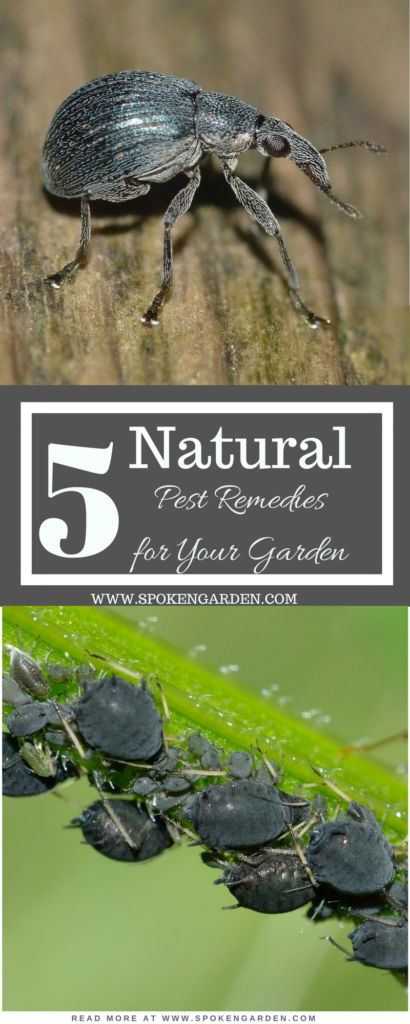
Spokengarden.com is a participant in the Amazon Services LLC Associates Program, an affiliate advertising program designed to provide a means for sites to earn advertising fees by advertising and linking to Amazon.com

